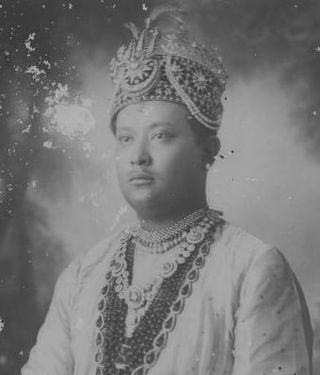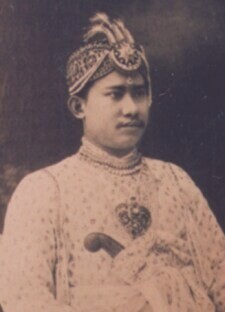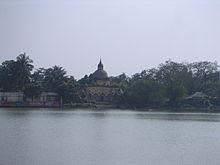
Agartala is the capital and the largest city of the Indian state of Tripura, situated on the banks of Haora/Saidra River, about 2 kilometres (1.2 mi) east of the border with Bangladesh and about 2,499 km (1,552 mi) from the national capital, New Delhi. According to 2022 AMC data, Agartala is the second most populous city after Guwahati in Northeast India. It is India's third international internet gateway and being developed under the Smart Cities Mission.

Maharaja Bir Bikram Airport, also known as Agartala Airport, is an international airport situated 12 kilometres northwest of Agartala, the capital of Tripura. It is administered by the Airports Authority of India (AAI). It is the second busiest airport in North-East India after Lokpriya Gopinath Bordoloi Airport in Guwahati and 29th busiest airport in India. It is the third international airport in North-East India, after Lokpriya Gopinath Bordoloi Airport and Imphal Airport.

The State of Tripura, in northeastern India, has a long history. The Twipra Kingdom at its peak included the whole eastern region of Bengal from the Brahmaputra River in the north and west, the Bay of Bengal in the south and Burma to the east during the 14th and 15th centuries AD.

The Tripuri are a Tibeto-Burman-speaking ethnic group of Bangladesh and Northeast Indian state of Tripura. They are the descendants of the inhabitants of the Twipra/Tripura Kingdom in North-East India and Bangladesh. The Tripuri people through the Manikya dynasty ruled the Kingdom of Tripura for over 600 years starting from 1400 A.D. until the kingdom joined the Indian Union on 15 October 1949. The Tipra Dynasty was established in 590 AD.

The Pushpabanta Palace also known as Kunjaban Palace is one of former royal palace of Tripura, it was built by Maharaja Birendra Kishore Manikya in 1917. It was the Raj Bhavan of Tripura till 2018, which later shifted. The palace is being developed as a national-level cultural museum.
The Twipra Kingdom was one of the largest historical kingdoms of the Tripuri people in Northeast India.

Maharaja Bir Bikram Kishore Manikya Bahadur was a king of Tripura State.He is popularly known as "The Architect Of Modern Tripura"

Neermahal also known as Twijilikma Nuyung is a former royal palace of Tripura Kingdom, built by Maharaja Bir Bikram Kishore Manikya bahadur in 1930. It is also the largest water palace in India. The palace is situated in the middle of Rudrasagar Lake, in Melaghar 53 kilometers away from Agartala, the capital of Tripura.

Chaturdasha Temple is a Hindu temple in Agartala, Tripura, India, and features the Tripuri dome patterned after the roofs of village huts in Tripura. The dome is surmounted by a stupa-like structure which reveals traces of Buddhist influence. This temple was built in honour of fourteen deities, together called the Chaturdasha Devata. Devotees visit the temple for the kharchi festival.

Ujjayanta Palace is the state museum of the Indian state of Tripura and former royal palace of the princely state of Tripura. It was built by Maharaja Radha Kishore Manikya in 1901. It housed the State Legislative Assembly up to 2011. The palace primarily showcases the lifestyle, arts, culture, tradition and crafts of communities residing in northeast India, along with many stone sculptures of the Manikya dynasty.
Jagannath Temple is a Hindu temple located within the Ujjayanta Palace grounds in Agartala, Tripura, India. Built by the Maharaja of Tripura of the Manikya Dynasty in the 19th century, the Jagannath temple is situated in the Ujjayanta Palace grounds and is dedicated to the Hindu Gods Jagannath, Balabhadra and Subhadra.

Birendra Kishore Manikya Debbarma Bahadur ascended the throne of the Kingdom of Tripura on 25 November 1909, at the age of 26.

Maharaja Radha Kishore Manikya of the Manikya Dynasty reigned as the king of Tripura State from 1897 to 1909. He has been described as one of the architects of modern Tripura.

Maharani Kanchan Prava Devi was a Queen of Tripura as the wife of Bir Bikram Kishore Debbarma, King of Tripura State. After her husband's death in 1947, she was regent of Tripura until it was merged with India in 1949.

Tripura State, also known as Hill Tipperah, was a princely state in India during the period of the British Raj and for some two years after the departure of the British. Its rulers belonged to the Manikya dynasty and until August 1947 the state was in a subsidiary alliance, from which it was released by the Indian Independence Act 1947. The state acceded to the newly independent Indian Union on 13 August 1947, and subsequently merged into the Indian Union in October 1949.
Raj Bhavan is the official residence of the governor of Tripura. The incumbent governor of Tripura is Hon'ble Shri Tathagata Roy. The residence is located in the state's capital city of Agartala. A new Raj Bhavan was built and inaugurated in April 2018. The previous Raj Bhavan was built in 1917, and was known as the Pushbanta Palace prior to India's independence. The previous Raj Bhavan edifice is intended to become a museum and research center in honor of King of Tripura, Maharaja Birendra Kishore Manikya.

The Chaturdasa Devata or Fourteen Gods is the Shaivite Hindu pantheon worshipped in the Indian state of Tripura.

Kokborok Cinema also known as Tripuri Cinema refers to the Kokborok language film industry in Tripura, India and among the Tripuri people. Tripura's Kokborok film industry began in 1986 with Longtharai (1986) directed by Dipak Bhattacharya adapted from Bimal Sinha's novel Karachi theke Longtharai depicting the struggle-ridden life of jhum cultivators in the rural hills of Longtharai followed by the Kokborok film Langmani Haduk (1993) directed by Ruhi Debbarma can be read as a critique of the modern regime. The Kokborok film Mathia (2004) directed by Joseph Pulinthanath, is the first International Award-winning Kokborok film.

Tripura is a state in the North-East India and the third smallest state in India. Tripura is widely regarded as a beautiful destination, appreciated for its picturesque landscape and delightful climate. The tourism in Tripura is maintained by TTDCL, a state government owned enterprise.

















